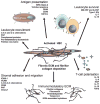Immune interactions in hepatic fibrosis
- PMID: 18984471
- PMCID: PMC2605646
- DOI: 10.1016/j.cld.2008.07.002
Immune interactions in hepatic fibrosis
Abstract
Liver cirrhosis is caused by iterative cycles of tissue injury, inflammation, and repair. Although most causes of acute hepatitis resolve without scarring, chronic hepatitis is associated with persistent inflammation and matrix remodeling, which leads to fibrosis and, eventually, cirrhosis. The mechanisms that govern wound healing involve interactions between the innate and adaptive immune systems and stromal cells within a microenvironment composed of cytokines, growth factors, and modified matricellular proteins. The immune system plays a central role in the regulation of fibrosis, tissue repair, and recovery that is vital for the maintenance of tissue homeostasis. Chronic inflammation and fibrosis are inextricably linked and the cellular interactions between immune effector cells, local fibroblasts, and tissue macrophages at sites of scar formation determine the outcome of liver injury and the development of scarring.
Figures




References
-
- Buckley CD, Pilling D, Lord JM, Akbar AN, Scheel-Toellner D, Salmon M. Fibroblasts regulate the switch from acute resolving to chronic persistent inflammation. Trends Immunol. 2001;22:199–204. - PubMed
Publication types
MeSH terms
Substances
Grants and funding
LinkOut - more resources
Full Text Sources
Medical

